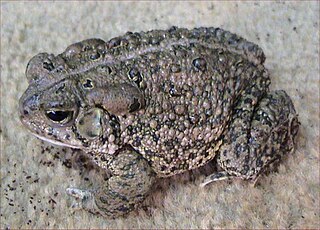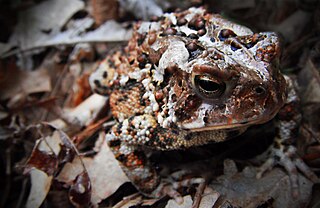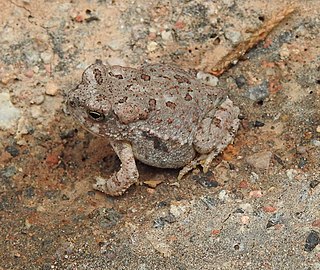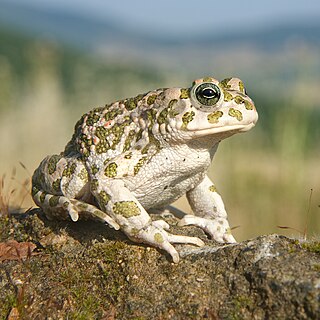
The common toad, European toad, or in Anglophone parts of Europe, simply the toad, is a frog found throughout most of Europe, in the western part of North Asia, and in a small portion of Northwest Africa. It is one of a group of closely related animals that are descended from a common ancestral line of toads and which form a species complex. The toad is an inconspicuous animal as it usually lies hidden during the day. It becomes active at dusk and spends the night hunting for the invertebrates on which it feeds. It moves with a slow, ungainly walk or short jumps, and has greyish-brown skin covered with wart-like lumps.

The American toad is a common species of toad found throughout Canada and the eastern United States. It is divided into three subspecies: the eastern American toad, the dwarf American toad and the rare Hudson Bay toad. Recent taxonomic treatments place this species in the genus Anaxyrus instead of Bufo.
Sclerophrys taiensis is a species of toad in the family Bufonidae. It is known from the Taï National Park in southwestern Ivory Coast and from the Gola Forest in southeastern Sierra Leone; it is likely that its range extends into the adjacent Liberia. Common name Tai toad has been proposed for it.

Woodhouse's toad is a medium-sized true toad native to the United States and Mexico. There are three recognized subspecies. A. woodhousii tends to hybridize with Anaxyrus americanus where their ranges overlap.

Fowler's toad is a species of toad in the family Bufonidae. The species is native to North America, where it occurs in much of the eastern United States and parts of adjacent Canada. It was previously considered a subspecies of Woodhouse's toad.

The Arabian toad is a species of toad in the family Bufonidae. It is endemic to the Arabian Peninsula and is found in Oman, Saudi Arabia, the United Arab Emirates, and Yemen.

Sclerophrys blanfordii is a species of toad in the family Bufonidae. It is found in northeastern Ethiopia, Somaliland, Djibouti, and Eritrea. The specific name blanfordii honours William Thomas Blandford, a British geologist and zoologist. Common names Blanford's toad and Ethiopia toad have been coined for it, the latter might specifically refer to the now-synonymized Bufo sibiliai.

Sclerophrys garmani, also known as Garman's toad or eastern olive toad, is a species of toad in the family Bufonidae. It is widely distributed in East and Southern Africa. However, populations north and south of Tanzania might represent distinct species. If so, the name Sclerophrys garmani would apply to populations from northeastern Africa. Furthermore, its southern boundary towards the range of Sclerophrys poweri in South Africa is also unclear.

The African common toad or guttural toad is a species of toad in the family Bufonidae. It is found in Angola, Botswana, Democratic Republic of the Congo, Kenya, Lesotho, Malawi, Mauritius, Mozambique, Namibia, Réunion, Somalia, South Africa, Ethiopia, Eswatini, Tanzania, Zambia, and Zimbabwe. Its natural habitats are subtropical or tropical dry forest, subtropical or tropical moist lowland forest, subtropical or tropical moist montane forest, dry savanna, moist savanna, temperate shrubland, subtropical or tropical dry shrubland, subtropical or tropical moist shrubland, subtropical or tropical dry lowland grassland, subtropical or tropical seasonally wet or flooded lowland grassland, subtropical or tropical high-altitude grassland, intermittent rivers, freshwater lakes, intermittent freshwater lakes, freshwater marshes, intermittent freshwater marshes, arable land, pastureland, rural gardens, urban areas, heavily degraded former forest, ponds, and canals and ditches.
The Nile Delta toad or Damietta toad is a species of toad in the family Bufonidae. It is endemic to Egypt, where it is found from the Nile Delta to as far south as Luxor. Its natural habitats are swamps, freshwater marshes, arable land, urban areas, seasonally flooded agricultural land and canals and ditches.
Sclerophrys kerinyagae is a species of toad in the family Bufonidae. It is found in central Ethiopia, Kenya, northern Tanzania, and eastern Uganda. Common names Keith's toad and Kerinyaga toad have been coined for it.
Sclerophrys langanoensis is a species of toad in the family Bufonidae. It is endemic to northern Rift Valley in Ethiopia, where it has been recorded from Lake Langano and the Awash National Park; the latter population might represent a distinct species. It is likely that this species will also be found in Eritrea and Somalia. Common name Lake Langano toad has been coined for it.

The Arizona toad is a species of toad in the family Bufonidae. It is endemic to the south-western United States, where its natural habitats are temperate lowland forests, rivers and streams, swamps, freshwater marshes, freshwater springs, ponds, open excavations, irrigated land, and seasonally flooded agricultural land.
Poyntonophrynus parkeri is a species of toad in the family Bufonidae. It is found in central Tanzania and in southwestern Kenya, from the Usangu Plain in the south northward to the southern Great Rift Valley, Kenya. It is a poorly known species, however, and its distribution might be broader.

Sclerophrys perreti is a species of toad in the family Bufonidae. It is endemic to the Idanre Hills in southwestern Nigeria. Sclerophrys perreti is one of the frogs declared as "Lost" in 2010. However, it was re-discovered at its type locality in 2013. Before that, it had not been seen—possibly—since 1970, and with certainty, since 1963. Common name Perret's toad has been coined for it.

The raucous toad, also known as Ranger's toad, is a species of toad from Southern Africa.

Sclerophrys regularis, commonly known as the African common toad, square-marked toad, African toad, Egyptian toad, African bouncing toad and Reuss's toad, is a species of toad in the family Bufonidae. It is found widely in the Subsaharan Africa, with its range extending to the oases in Algeria and Libya as well as to northern Nilotic Egypt. Specifically, it is found in Angola, Benin, Burkina Faso, Cameroon, Cape Verde, Central African Republic, Chad, Republic of the Congo, Democratic Republic of the Congo, Ivory Coast, Egypt, Ethiopia, Gabon, Ghana, Guinea, Guinea-Bissau, Kenya, Liberia, Mali, Niger, Nigeria, Rwanda, Senegal, Sierra Leone, Sudan, and Uganda.
Sclerophrys tuberosa is a species of toad in the family Bufonidae. It is found in southeastern Nigeria, Cameroon, southwestern Central African Republic, Equatorial Guinea, Gabon, and northern Democratic Republic of the Congo and Republic of the Congo. Common names rough toad, warty toad, and Fernando Po toad have been proposed for it.

The golden toad is an extinct species of true toad that was once abundant in a small, high-altitude region of about 4 square kilometres (1.5 sq mi) in an area north of the city of Monteverde, Costa Rica. It was endemic to elfin cloud forest. Also called the Monte Verde toad, Alajuela toad and orange toad, it is commonly considered the "poster child" for the amphibian decline crisis. This toad was first described in 1966 by herpetologist Jay Savage. The last sighting of a single male golden toad was on 15 May 1989, and it has since been classified as extinct by the International Union for Conservation of Nature (IUCN).

Bufotes, the Eurasian green toads or Palearctic green toads, is a genus of true toads. They are native to Europe, western and central Asia and northern Africa; a region roughly equalling the western and central Palearctic. Historically they were included in the genus Bufo and then for a few years placed in Pseudepidalea, which is a synonym of the currently accepted name Bufotes.














